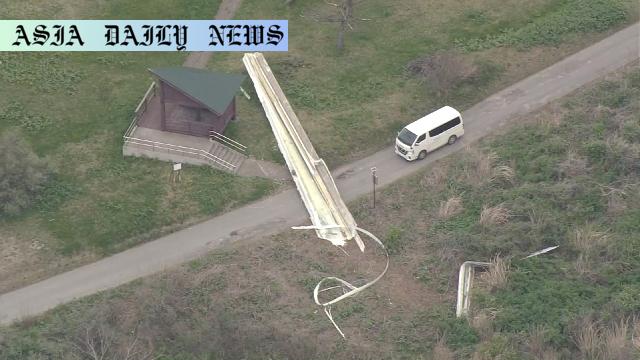Wind turbine accident highlights concerns over maintenance and safety protocols following a fatal incident in Akita, Japan.
- A wind turbine blade fell in Akita, Japan, killing an 81-year-old man.
- Strong wind advisory and gusts of over 82 km/h were reported during the incident.
- Experts suggest undetected turbine damage caused by past events like lightning strikes.
- A similar incident occurred in the prefecture back in 2010, but with no fatalities.

The Incident and Immediate Consequences
The tragic collapse of a wind turbine blade in Akita, Japan, has brought renewed attention to the safety of renewable energy technologies. The accident occurred in a park, where a 40-meter-long blade detached from a turbine and led to the death of an 81-year-old man found collapsed near the site. Despite quick actions by emergency services, including his transportation to a hospital, the man could not be revived. This fatality marks a significant moment for the region, especially given its history with turbine-related mishaps.
Weather Conditions: A Contributing Factor?
Strong winds plagued Akita City at the time of the accident, with gusts exceeding 82 kilometers per hour. A strong wind advisory had been issued earlier that day, raising questions about whether weather conditions contributed to the blade’s failure. However, experts, including Professor Nagao Toru of Ashikaga University, believe the winds alone may not have been enough to damage the turbine, which was designed to withstand high-pressure forces. Instead, the professor hypothesized that issues such as past lightning strikes, poor maintenance, or undetected cracks may have played a larger role in causing the blade to fail.
Maintenance Protocols Under Scrutiny
This incident has intensified scrutiny over the maintenance practices for wind turbines in Akita and similar installations across Japan. The turbine involved in Friday’s accident had been operational since 2009, and officials are investigating whether routine inspections were sufficient to identify potential issues. It is worth noting that a similar incident occurred in the area in 2010, although it did not result in injuries. This pattern raises critical questions about the oversight of such devices in high-risk weather regions and whether current regulations are adequate for identifying vulnerabilities before they lead to disasters.
The Future of Wind Energy Investment
Renewable energy sources like wind power are vital for reducing global carbon emissions and combating climate change. However, incidents like this raise important considerations about the balance between expansion efforts and ensuring operational safety. As Japan continues to expand its renewable energy sector, the challenge of maintaining not only the efficiency but also the safety of installations remains paramount. Accidents of this nature, if perceived as systemic, could deter public support and investor confidence in wind energy projects, making it even more critical for authorities to address safety lapses decisively.
Global Implications
Wind energy technology has been adopted globally as a key component of sustainable energy strategies. The Akita accident serves as a stark reminder for the international community to prioritize stringent safety measures and regular inspections. As extreme weather events become increasingly frequent in the era of climate change, ensuring the reliability of wind turbines will be crucial to prevent similar incidents. Additionally, incorporating advanced monitoring technologies could be an effective strategy to detect and address potential flaws before they escalate into larger threats.



Commentary
Reflection on the Akita Wind Turbine Accident
The tragic accident involving the fallen wind turbine blade in Akita, Japan, forces us to take a step back and consider broader issues surrounding renewable energy safety. Although renewable energy is a cornerstone of combating climate change, incidents like this highlight the inherent risks if safety protocols are not prioritized. Lives should never become the cost of progress in clean energy adoption.
Questions on Maintenance and Oversight
A significant part of the discussion revolves around maintenance and oversight. Wind turbines, despite being seen as robust and durable structures, require consistent inspections to identify less visible wear and tear. The possibility of damage caused by previous incidents, such as lightning strikes, going unnoticed raises questions about whether current maintenance protocols are robust enough to prevent such mishaps. Authorities and operators need to strike a balance between efficiency and safety by investing in advanced monitoring technologies and rigorous safety checks.
Importance of Transparency and Public Confidence
Transparency is another critical issue here. The public needs to feel confident that renewable energy technologies, which are being increasingly integrated into urban and rural areas, do not pose undue risks. A similar incident in Akita in 2010, although nonfatal, suggests a possible pattern that necessitates deeper investigations. Transparent reporting and visible steps to improve safety protocols will be essential for maintaining public trust and support for renewable energy initiatives in Japan and beyond.
The Broader Significance for Renewable Energy
Finally, this incident serves as a wake-up call for the global renewable energy sector. As climate change intensifies weather extremities, resilience and safety must become paramount in the design and operation of renewable energy installations. By addressing these challenges proactively, the sector can not only prevent future tragedies but also solidify its role as a safe and sustainable alternative to fossil fuels.